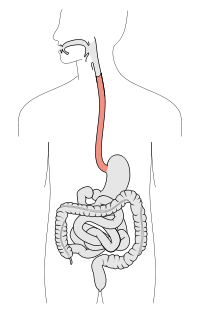
Photo from wikipedia
Background/Aims Patients with achalasia-related esophageal motility disorders (AEMDs) frequently present with dilated and sigmoid esophagus, and develop esophageal diverticulum (ED), although the prevalence and patients characteristics require further elucidation. Methods… Click to show full abstract
Background/Aims Patients with achalasia-related esophageal motility disorders (AEMDs) frequently present with dilated and sigmoid esophagus, and develop esophageal diverticulum (ED), although the prevalence and patients characteristics require further elucidation. Methods We conducted a multicenter cohort study of 3707 patients with AEMDs from 14 facilities in Japan. Esophagography on 3682 patients were analyzed. Results Straight (n = 2798), sigmoid (n = 684), and advanced sigmoid esophagus (n = 200) were diagnosed. Multivariate analysis revealed that long disease duration, advanced age, obesity, and type I achalasia correlate positively, whereas severe symptoms and integrated relaxation pressure correlate negatively with development of sigmoid esophagus. In contrast, Grade II dilation (3.5-6.0 cm) was the most common (52.9%), while grade III dilation (≥ 6 cm) was rare (5.0%). We found early onset, male, obesity, and type I achalasia correlated positively, while advanced age correlated negatively with esophageal dilation. Dilated and sigmoid esophagus were found mostly in types I and II achalasia, but typically not found in spastic disorders. The prevalence of ED was low (n = 63, 1.7%), and non-dilated esophagus and advanced age correlated with ED development. Patients with right-sided ED (n = 35) had a long disease duration (P = 0.005) with low integrated relaxation pressure values (P = 0.008) compared with patients with left-sided ED (n = 22). Patients with multiple EDs (n = 6) had lower symptom severity than patients with a single ED (P = 0.022). Conclusions The etiologies of dilated esophagus, sigmoid esophagus, and ED are considered multifactorial and different. Early diagnosis and optimal treatment of AEMDs are necessary to prevent these conditions.
Journal Title: Journal of neurogastroenterology and motility
Year Published: 2022
Link to full text (if available)
Share on Social Media: Sign Up to like & get
recommendations!